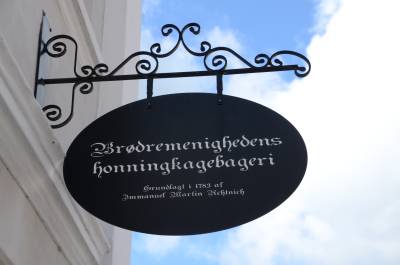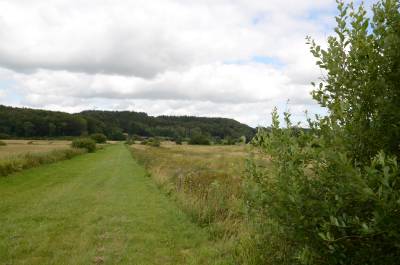New and old sights and going home
 The last day of our trip.We were about to head for Brøndby but we wanted to
make it the last sightseeing excursion as well. We packed our car and left
Rønhave and a few minutes later we also left the island of Als and headed north
through the towns Aabenraa and Haderslev. Passing through the latter, we crossed
a small creek, Møllestrøm or Mill Stream. It connects what is known as Haderslev
Dam (Haderslev Pond) with Haderslev Fjord. The Pond is known for a ship wreck
that took place in 1959. A tour boat caught fire and 57 out of 93 passengers
died; burned to death or drowned.
The last day of our trip.We were about to head for Brøndby but we wanted to
make it the last sightseeing excursion as well. We packed our car and left
Rønhave and a few minutes later we also left the island of Als and headed north
through the towns Aabenraa and Haderslev. Passing through the latter, we crossed
a small creek, Møllestrøm or Mill Stream. It connects what is known as Haderslev
Dam (Haderslev Pond) with Haderslev Fjord. The Pond is known for a ship wreck
that took place in 1959. A tour boat caught fire and 57 out of 93 passengers
died; burned to death or drowned.
From Haderslev we headed for the first goal of the day, the small town of Christiansfeld. It was founded in 1773 by members of the Moravian Church who were promised ten years without taxation by the king. The center of town is still following the town plan made then, and all the houses are built from yellow bricks and most was built before 1800. The town is famous for the ginger cakes, that are baked there, and we stopped to buy a few to take home as presents. We took some pictures of the houses and streets, that are rather particular in Denmark.
From Christiansfeld we headed further north to Skamlingsbanken. This is a hill near Lillebælt, that has been used as a national gathering point for many years, mainly in the late 1800's. We took pictures of the views from the hill and of some of the many monuments erected there. From Skamlingsbanken we headed north to Kolding, and then turned west once more to the small village Egtved, where the Egtved Girl was found. She was a woman or rather a young girl from the bronzeage, who died around 1370 bc at around 17 years of age. Modern research has shown that she travelled a lot between southern Germany and Jylland and that she was probably born somewhere in The Black Forests. As the girl is in the National Museum in Copenhagen and we visited the gravesite and small museum in 2014, we continued through Egtved to Randbøl Hede, the largest inland heath area in Denmark. In the old days robbers roamed the heath but today only a few tourists are seen here. Next to the heath is Frederikshåb Plantage, a forested area famous for the so-called 7-year lakes. A number of lakes, that are sometimes dry and sometimes filled with water (around every seventh year). Next stop was Vingsted next to River Vejle Å, where I spent some vacations as a child. Today it is a modern conference center, but back in the sixties it was way more modest. The swimming pool had a sandy bottom and frogs and salamanders were swimming in the water.
 From Vingsted we headed to Ravning Enge, a part
of River Vejle Å Valley. Around 980 AD, a bridge was build that crossed the
valley, more than 2000 feet in lenght and 15 feet wide. A very impressive
construction from the viking ages. To preserve the remains of the bridge it is
covered with earth, but a replica of a small part the bridge has been bulit next
to the road. Nobody knows for sure, who was responsible for the building of the
bridge, but regarding the time, it was most certainly King Harald Bluetooth.
When we had taken pictures of the replica we moved on to Vejle, a town that I
have visited many times, both in my youth (we had family in the area) and as
adult, when I worked for IBM and served customers in that area. In Vejle we
visited an old mill, and took some pictures of the bridge crossing Vejle Fjord.
A 5,600 feet long cantilever bridge, with a 130 feet clearance to sealevel.
Even if built in modern times its still an impressive work. From the bridge we
took the road to Munkebjerg, a 305 feet hill, with a hotel and casino on top. We
didn't visit though, as we wanted to get home.
From Vingsted we headed to Ravning Enge, a part
of River Vejle Å Valley. Around 980 AD, a bridge was build that crossed the
valley, more than 2000 feet in lenght and 15 feet wide. A very impressive
construction from the viking ages. To preserve the remains of the bridge it is
covered with earth, but a replica of a small part the bridge has been bulit next
to the road. Nobody knows for sure, who was responsible for the building of the
bridge, but regarding the time, it was most certainly King Harald Bluetooth.
When we had taken pictures of the replica we moved on to Vejle, a town that I
have visited many times, both in my youth (we had family in the area) and as
adult, when I worked for IBM and served customers in that area. In Vejle we
visited an old mill, and took some pictures of the bridge crossing Vejle Fjord.
A 5,600 feet long cantilever bridge, with a 130 feet clearance to sealevel.
Even if built in modern times its still an impressive work. From the bridge we
took the road to Munkebjerg, a 305 feet hill, with a hotel and casino on top. We
didn't visit though, as we wanted to get home.
From Vejle we headed home, only with a short stop in Fredericia, so Tim could see the house his great grandparents had lived in. We crossed Fyn and the Great Belt Fixed Link, and an hour after getting to Sjælland we were back home after 2,810 kilometers (1,750 miles) on the Danish Roads.